Summary: A new study reports those with alcohol use disorders have a decrease in glutamate levels in the brain when shown cues associated with drinking.
Source: Indiana University.
A study led by Indiana University on neurochemical changes associated with alcohol addiction found that the neurotransmitter glutamate plays a role in some alcohol cravings.
Alcohol dependence and alcohol use disorders occur in about 30 percent of all Americans, taking a severe toll on people’s lives, as well as on the health care system and economy. Ninety percent of all attempts to cure the dependence or abuse of alcohol result in relapse within four years. These relapses are primarily triggered by sights, sounds and situations associated with past drinking experiences.
“This is the first study to document changes in glutamate levels during exposure to alcohol cues in people with alcohol use disorders and shines a spotlight on glutamate levels as an important target for new therapies to treat the condition,” said Sharlene Newman, a professor in the IU Bloomington College of Arts and Sciences’ Department of Psychological and Brain Sciences.
The study, recently published in the Journal of Alcohol and Alcoholism, builds upon research by scientists such as George Rebec, a professor emeritus in the Department of Psychological and Brain Sciences who previously found that sights and sounds associated with addictive substances such as cocaine or alcohol affect glutamate levels in the brains of rats addicted to these substances. These sights and sounds are called “cues” because they elicit a craving for the previously abused substance.
“Glutamate is the real workhorse of all transmitters in the brain,” Rebec said. “Dopamine is the more popularly known neurotransmitter, a lack of which contributes to depression, anxiety, attention deficit hyperactivity disorder and Parkinson’s disease — but it actually accounts for less than 5 percent of all synaptic activity. By contrast, glutamate?accounts for about 50 percent of this activity and is especially involved in the reward-motivation circuits integral to addiction.”

To conduct the new study, researchers enlisted 35 subjects, 17 with alcohol use disorder and 18 without the disorder. Then they measured concentrations of glutamate using a technology called magnetic resonance spectroscopy. The study found a decrease of the chemical in the brain of people with alcohol abuse disorder after they were shown cues associated with drinking — such as a photo of alcohol in a glass — compared to when they viewed neutral photos. Individuals without the disorder showed no change in glutamate levels when viewing the same images.
“We recognized we could measure glutamate levels in the human brain using magnetic resonance spectroscopy,” said Newman, who led the collaboration between her department’s addiction researchers to build upon Rebec’s previous work in animals. “Scientists can now confidently target glutamate levels in the brain as they develop new treatments for alcoholism and other forms of addiction.”
Technical expertise on the use of magnetic resonance spectroscopy to measure glutamate levels was provided by Newman, director of the IU Imaging Research Facility; Hu Cheng, a senior scientist in the Department of Psychological and Brain Sciences; and Ulrike Dydak, a professor in the School of Health Sciences at Purdue University. IU professor Peter Finn, a clinical psychologist who studies decision-making behavior in the early stages of alcohol use disorders, assisted in the recruitment of participants in the study.
Additional authors were Rebec; undergraduate research assistant Derek Kellar and graduate student Allison Lake in the Department of Psychological and Brain Sciences; and Shalmali Dharmadhikari, a former graduate student in Dydak’s lab at Purdue. Newman is also the associate vice provost for undergraduate education at IU Bloomington.
Funding: This study was funded in part by the National Institutes of Health’s National Institute on Alcohol Abuse and Alcoholism and the Indiana Clinical and Translational Sciences Institute.
Source: Kevin Fryling – Indiana University
Publisher: Organized by NeuroscienceNews.com.
Image Source: NeuroscienceNews.com image is credited to Hu Chang, Indiana University.
Original Research: Abstract in Journal of Alcohol and Alcoholism.
doi:10.1093/alcalc/agx119
[cbtabs][cbtab title=”MLA”]Indiana University “Glutamate May Play a Role in Addiction and Alcohol Relapse.” NeuroscienceNews. NeuroscienceNews, 13 February 2018.
<https://neurosciencenews.com/glutamate-addition-relapse-8481/>.[/cbtab][cbtab title=”APA”]Indiana University (2018, February 13). Glutamate May Play a Role in Addiction and Alcohol Relapse. NeuroscienceNews. Retrieved February 13, 2018 from https://neurosciencenews.com/glutamate-addition-relapse-8481/[/cbtab][cbtab title=”Chicago”]Indiana University “Glutamate May Play a Role in Addiction and Alcohol Relapse.” https://neurosciencenews.com/glutamate-addition-relapse-8481/ (accessed February 13, 2018).[/cbtab][/cbtabs]
Abstract
Effects of Alcohol Cues on MRS Glutamate Levels in the Anterior Cingulate
Growing evidence suggests that glutamate neurotransmission plays a critical role in alcohol addiction. Cue-induced change of glutamate has been observed in animal studies but never been investigated in humans. This work investigates cue-induced change in forebrain glutamate in individuals with alcohol use disorder (AUD). A total of 35 subjects (17 individuals with AUD and 18 healthy controls) participated in this study. The glutamate concentration was measured with single-voxel 1H-MR spectroscopy at the dorsal anterior cingulate. Two MRS sessions were performed in succession, the first to establish basal glutamate levels and the second to measure the change in response to alcohol cues. The changes in glutamate were quantified for both AUD subjects and controls. A mixed model ANOVA and t-tests were performed for statistical analysis. ANOVA revealed a main effect of cue-induced decrease of glutamate level in the anterior cingulate cortex (ACC). A significant interaction revealed that only AUD subjects showed significant decrease of glutamate in the ACC. There were no significant group differences in the level of basal glutamate. However, a negative correlation was found between the basal glutamate level and the number of drinking days in the past 2 weeks for the AUD subjects. Collectively, our results indicate that glutamate in key areas of the forebrain reward circuit is modulated by alcohol cues in early alcohol dependence.







